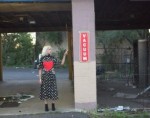
Photo: Zaitoun Dabke Dance Troupe Boston
Palestinian Dabke Makes it to the Annenberg
by Nicole Bindler
On November 14th the Philadelphia Coalition for Boycott, Divestment, and Sanctions against Israel (Philly BDS) and partners from Students for Justice in Palestine staged a protest against Kibbutz Contemporary Dance Company (KCDC) outside the Annenberg Center for the Performing Arts. Here Nicole Bindler, who has taught in Palestine and is a member of the Jewish Voice for Peace Artist Council, investigates the questions surrounding the cultural and academic boycott of Israel through interviews with Philly BDS members and artists. In a thINKingDANCE companion piece she reviews Kibbutz Contemporary Dance Company’s performance at the Annenberg.
There is no Palestinian dance inside of the Annenberg tonight, or for that matter at any large dance venues in the United States. But it is performed in small theaters, community spaces and on sidewalks at demonstrations as an assertion of Palestinian culture and resistance.
Ten people hold hands in the cold. They stomp, left feet in front of right, as they arc across the sidewalk. A woman in the group shouts “Come dance
Dabke for justice!”
Zareef et Tool, a folk song that urges Palestinians to remain in their homeland, blares and crackles out of a boom box on the ground. “Aywa!” a woman hollers, encouraging the protest-dancers to continue. They are scrappy and lack unison, but they are joyous. One couple reads the flyer handed to them by a protester that says: “Don’t dance with Israeli Apartheid.” They consider the reasons for boycott listed on the back and decide to skip the show. A demonstrator stands by the stereo wearing a
keffiyeh, a tutu and a broad grin.
Susan Landau of Philly BDS and Philadelphia Jews for a Just Peace explains why we see very little Palestinian dance represented on the international touring circuit: “First, Palestinians in the West Bank live under Israel’s illegal military occupation, which includes policies of restricted movement within the West Bank and no permission to travel within Israel. The Israeli government must grant all documents necessary for foreign travel. Second, the ongoing occupation with its apartheid infrastructure, denies Palestinians equal rights, access to a basic standard of dignity and the allocation of fundamental resources, let alone funding for dance.”
Defense and rebuttal
As Kibbutz Contemporary Dance Company is met by protesters in many cities, the company claims to disavow politics. Yoni Avital, International Director of KCDC wrote in a letter to protesters in Cleveland: “I recognize the fact that your organization is planning a protest that is politically-motivated, but at the same time, it is important that you and your fellow colleagues understand the depth and the founding principles of KCDC; a company whose mission is to bring people of all backgrounds together through the performing arts no matter their race or creed. We are most certainly not a political organization, but one built of individuals who do not represent any particular political views.”
Tory Smith, Palestine solidarity activist based in Philadelphia, explains why he believes there is something inherently political about KCDC touring to the United States: “They are sponsored by the
Israeli Ministry of Foreign Affairs and the
Israeli Ministry of Sports and Culture, and this particular event is sponsored by the
Israeli Consulate in Philadelphia. As part of ‘
Brand Israel’, KCDC has to sign a
contract as a condition of government funding stating that: ‘The service provider [in this case, KCDC] is aware that the purpose of ordering services from him is to promote the policy interests of the state of Israel via culture and art, including contributing to creating a positive image for Israel.’ As such, we view this dance company as an extension of Israeli governmental policy, which sets them apart from a dance company simply based in Israel.”
Evan Hoffman, Philadelphia-based dancer and educator, describes why he’s protesting: “I am very concerned about art being ethical and transparent. The fact that KCDC is directly tied to the Israeli Ministry of Foreign Affairs and has been sent out into the world to spread and encourage a favorable view of the state of Israel is very troubling to me. It sanitizes the occupation of Palestine and helps Israel wash its hands of wrongdoing or responsibility in the eyes of foreign audiences.” The haunting and anguished performance of KCDC’s If At All does not deny the conflict, but the goal of Israel’s government funding of KCDC is to deflect attention away from the occupation. The question of the cultural boycott’s efficacy centers around whether an artist is responsible for the agenda of their funder.
BDS context
Smith gives some context for the protest: “This movement takes as inspiration the movements of the Civil Rights and the South African Apartheid struggles, both of which involved multiple points of pressure, boycotts among them, to transform the socio-political systems that ran the Jim Crow South and Apartheid.”
This protest is not an isolated incident. On November 12th the New York Campaign for the Boycott of Israel (
Adalah-NY) organized a
protest outside of the Batsheva concert at the Brooklyn Academy of Music. NYC Organizer and musician Dave Lippman describes to me how the cultural boycott is more likely successful as an educational tool rather than as economic pressure: “Gradually, as more artists come to understand their responsibilities, more will stop propping up the wall, and we can expect a great rise in consciousness and action, from both performers and audiences.”
Philly BDS activists direct me to the writings of leaders in the BDS movement for examples of artists and academics who experience injustice in Israel. Omar Barghouti, a founding committee member of the Palestinian Campaign for the Academic and Cultural Boycott of Israel (PACBI) tells an anecdote about the poor treatment of an American dancer touring to Israel in his book BDS: The Global Struggle for Palestinian rights: “Security officers at Tel Aviv’s Ben Gurion Airport in September 2008 forced an African American member of the Alvin Ailey American Dance Theater–by far the best known touring dance company in the United States–to perform twice for them in order to prove he was a dancer before letting him enter the country. Even after he complied, one of the officers suggested that Abdur-Rahim Jackson change his name. Jackson felt humiliated and deeply saddened according to an Ailey spokesperson.”
Ilan Pappe, an Israeli Academic writes in
Generation Palestine: Voices from the Boycott, Divestment and Sanctions Movement about how freedom of speech is suppressed in Israeli academia in order to maintain the occupation: “My own case study, of a lecturer who was ousted because of his resistance to the policies of the state and the continued harassment of my colleagues with similar views by the Universities, illustrates forcefully why the boycott of Israeli academia abroad was justified, not just as part of the overall pressure on the Jewish state to end its brutal occupation, but also as a warning to the scholarly community in Israel that its protracted moral cowardice had a price tag on it.” As a result of the
Law for Prevention of Damage to State of Israel through Boycott Israeli academics and artists alike avoid criticism of the state in their work in order to keep their jobs and funding.
Nuances of opinion and ambivalence
All of the interviewed members of Philly BDS say they are not opposed to supporting Israeli artists or scholars whose funding, research and artistry is not tied to the occupation. Regardless of this distinction between individuals and their government, the
BDS movement in general and the
cultural and academic boycott specifically is a volatile subject. There are those who oppose the occupation but do not feel that BDS is an effective strategy. Some support BDS but draw the line at boycotting the arts and academia. Some express ambivalence and others are ardent.
Jesse Kudler, Philadelphia-based musician, opposes the occupation but is unconvinced that BDS is a practical strategy. “I'm generally skeptical of consumer boycotts as effective tools for change in most cases, and particularly I'm skeptical of one so broad that it often targets the arts or academia. KCDC gets Israeli government funds to further Israel's positive image abroad, but I find it a little tough to judge an arts group too harshly for taking government money-- it's very hard to sustain one's work otherwise. Certainly, the US has used and continues to use art abroad to promote a favorable image, and a lot of foundation money or money from other governments is likewise tainted by material support for objectionable or immoral policies.”
Zoe Cohen, Philadelphia-based visual artist and educator differentiates her feelings about BDS and the cultural boycott: “The BDS movement is one effective way to put pressure on a government that is clearly committing human rights violations, but artists and cultural workers are generally the most flexible thinkers, and to cut off their ability to connect and communicate with people outside of their own cultural realm seems to me to be a good way to prevent open communication and dialogue.”
An Israeli-American, New York-based choreographer who has asked to be anonymous because her family would not approve of her politics says: “I am ambivalent, I both support BDS and others in their protests as they stand in solidarity with Palestinians. I am not sure I myself would participate. I have chosen not to attend Israeli performances for a while, but also have yet to participate in the organized boycott. I see BDS as a powerful call to keep Israel accountable for its actions, but I am on the fence about it. As an Israeli-American with family in Israel I am wondering how I can stand in solidarity with Israelis and not the state’s actions.”
Community engagement and mutuality
In his letter, Yoni Avital discusses pluralism within the company as a counter to the protest and antidote to the conflict in Israel: “KCDC, despite the fact that we're situated in Israel, is an exemplary organization committed to co-existence projects and development of dance programs in the Arab community. One of our organization's central missions is to reach out to Arab communities and Arab youth in order to develop dance education programs and dancers alike in their communities. Dancers from our main company regularly teach in neighboring Arab villages and we've also had Arab dancers dance in our company.”
Members of Philly BDS express concern that when Israelis organize community outreach for Palestinians without recognition of the severe asymmetry of power between them, the unfair conditions that Palestinians endure is made invisible. Abbas Naqvi, doctoral student in biology and Philly BDS member, sums it up: “The bottom line is, we, as justice-seeking individuals support independent artists who are trying to ‘sow peace,’ not through co-existence, because that would entail normalizing Israel as it commits crimes against humanity, but rather through shared values in the form of co-resistance.”
By Nicole Bindler
November 25, 2014










